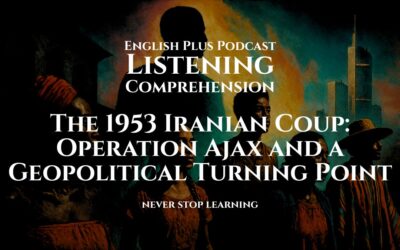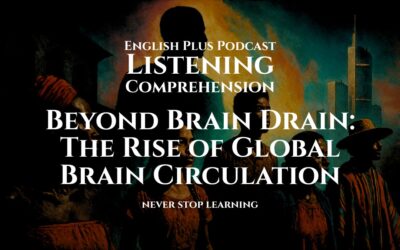Improve Your Listening with the Power of Observation
Welcome to your listening practice session! In high-stakes exams like the TOEFL or IELTS, you’re often listening to academic lectures. The speakers present a main idea and then support it with details, examples, and reasons. Your job isn’t just to hear the words, but to understand the structure of the argument.
A great tip for these lectures is to practice active listening. Don’t just let the sound wash over you. Instead, try to think like a detective. Ask yourself: What is the speaker’s main point? What evidence are they using to support it? How does this example connect to the main idea? In today’s lecture, we’re going to explore this very idea by examining the methods of the world’s most famous fictional detective, Sherlock Holmes. As you listen, try to separate the main concepts from the specific examples used to illustrate them. This will help you answer both main idea questions and detail-oriented questions later.
Anticipate the Topic
You are about to listen to a lecture on the “Sherlock Holmes method.” You will hear the speaker discuss the difference between simply seeing something and truly observing it. The lecture will break down the detective’s thinking process, moving from observation to inference and finally to deduction. Listen for the key steps in this process and how they are applied to solve a case.
Advanced Vocabulary and Phrases
Here are some advanced words and phrases from the lecture. Understanding them will help you follow the main points.
Deduction (n.): The process of reaching a conclusion by using logic and reasoning based on general principles or established facts.
How it’s used in the listening: The speaker defines deduction as the cornerstone of the “Sherlock Holmes method,” explaining it as the final step of reasoning from a general truth to a specific conclusion.
Inference (n.): An educated guess or conclusion you draw based on evidence and reasoning, but which is not explicitly stated.
How it’s used in the listening: The lecture positions inference as the bridge between observation and deduction, the moment Holmes forms a hypothesis based on the clues he has gathered.
Keen observation (phrase): The ability to notice small, significant details that others might miss.
How it’s used in the listening: This phrase is used to describe Holmes’s primary skill, emphasizing that his genius begins with his highly developed ability to notice everything.
Empirical evidence (phrase): Information that is gathered through direct observation, experience, or experimentation.
How it’s used in the listening: The speaker stresses that Holmes’s methods, though they seem magical, are grounded in empirical evidence—the tangible clues he collects from a crime scene.
Fallacious reasoning (phrase): Thinking that is based on a mistake or a false belief. A flawed argument.
How it’s used in the listening: This is mentioned as what Holmes actively avoids. He criticizes others for jumping to conclusions based on emotion, which is a form of fallacious reasoning.
Cerebral (adj.): Relating to the intellect; involving deep, careful thought rather than emotion.
How it’s used in the listening: The speaker describes Holmes’s approach as purely cerebral, meaning he solves crimes using his mind and logic, keeping personal feelings separate.
Astute (adj.): Having the ability to accurately notice and understand things that are not obvious.
How it’s used in the listening: The lecture refers to Holmes as an astute investigator, highlighting his cleverness in interpreting the meaning behind the details he observes.
Meticulous (adj.): Showing great attention to detail; very careful and precise.
How it’s used in the listening: This word is used to characterize Holmes’s examination of clues. He is described as being meticulous in his work, leaving no stone unturned.
Unravel (v.): To investigate and solve a complex problem or mystery.
How it’s used in the listening: The speaker uses “unravel the case” to describe the process of solving the crime, much like one would pull a thread to unravel a knot.
Premise (n.): A statement or idea that is accepted as true and is used as the basis for developing an argument.
How it’s used in the listening: The lecture explains that every one of Holmes’s deductions starts with a solid premise based on his observations. If the premise is true, the conclusion must follow.
Listening Audio
Listening Transcript: Please do not read the transcript before you listen and answer the questions.
Good morning, everyone. In our discussion of critical thinking and logical reasoning, it’s almost impossible to avoid a certain figure from literature, a man who, though fictional, has become the archetype of the brilliant analytical mind: Sherlock Holmes. When Sir Arthur Conan Doyle created Holmes, he introduced the world to what he called “The Science of Deduction.” But what exactly is this science? Is it a real, applicable method, or simply a clever literary device? Today, we’re going to dissect the Sherlock Holmes method, breaking it down into its core components to understand how it functions not just as a tool for solving fictional crimes, but as a model for a more rigorous and effective way of thinking.
The most famous quote attributed to Holmes, one that he often directed at his friend Dr. Watson, is, “You see, but you do not observe.” This single sentence is the absolute foundation of the entire method. It highlights the critical distinction between passive sight and active observation. Most of us go through our days simply seeing the world around us. We register faces, objects, and environments on a superficial level. To observe, however, is an entirely different cognitive process. Observation is seeing with intention. It is a meticulous and focused examination of details with the specific goal of gathering information. Holmes’s genius did not begin with his conclusions; it began with his ability to gather a vast amount of data from the smallest of details—the fraying of a cuff, a specific type of mud on a boot, the calluses on a man’s hand. This is the first step: a commitment to deep, keen observation. This is the collection of empirical evidence, the raw data from which all logic must flow. Without high-quality data, any subsequent reasoning is built on a weak foundation.
Once the data is collected, the second step begins: inference. This is where Holmes starts to build hypotheses. An inference is an educated guess, a potential explanation for the observed facts. If Holmes observes that a man has a tan line on his ring finger, he might infer that the man was recently married and is now trying to hide that fact. This isn’t a certainty yet; it’s a possibility. This is a crucial distinction. Holmes often formulated several possible inferences or explanations for a single set of observations. He would then hold these theories in his mind, testing them against new information as it arrived. This willingness to entertain multiple possibilities without prematurely committing to one is a hallmark of a flexible and powerful intellect. He avoids the trap of confirmation bias, where one seeks out information that supports a pre-existing belief. Instead, he follows the evidence wherever it leads. His mind is a workshop of ideas, constantly building and dismantling theories. This process is not about finding the most exciting or dramatic explanation, but the one that best fits the existing facts. It’s a cerebral exercise, one that demands patience and objectivity.
This leads us to the third and most famous step: deduction. Now, it’s important to clarify a common point of confusion. While Conan Doyle calls it “deduction,” many of Holmes’s methods are technically a form of abductive reasoning—which is reasoning to the most likely explanation. However, the classic form of deduction is what he uses to finalize his cases. Deduction is reasoning from the general to the specific. It starts with a general premise or rule that is known to be true and applies it to a specific instance. The classic example is: All men are mortal (premise 1). Socrates is a man (premise 2). Therefore, Socrates is mortal (conclusion).
How does Holmes use this? After observing and making inferences, he establishes a set of premises he is almost certain are true. For example, in “The Adventure of the Blue Carbuncle,” Holmes deduces a man’s entire life story from a battered old hat. He observes the hat’s size, quality, and condition. From its large size, he infers the man is intellectual. From its once-fine quality but current disrepair, he infers the man has fallen on hard times. Each of these is a small inference. He then chains them together. Premise 1: Educated men who were once wealthy but are now poor often become sedentary and less concerned with their appearance. Premise 2: This hat belongs to such a man. Conclusion: Therefore, the owner of this hat is likely an intellectual who has suffered a misfortune and lost his self-respect. He constructs a logical chain where, if each link is sound, the final conclusion is almost inescapable. His brilliance lies in ensuring each premise is rock-solid, based on his astute and meticulous observation.
Let’s apply this three-step process—observation, inference, deduction—to a brief, practical example from the stories. Imagine a client walks into 221B Baker Street. Holmes doesn’t just see a man; he observes. He sees a slight limp in the man’s left leg, but notices the man’s boots are equally worn. He sees a ticket stub peeking from the man’s pocket, the type used for a specific train line. He observes the man’s coat is of a military cut but is worn with civilian trousers. From these observations, he makes inferences. The equal wear on the boots suggests the limp is not from a long-term injury but is perhaps psychosomatic or recently acquired. The military coat suggests a past in the army. The train ticket points to his recent location.
Now, the deduction. Holmes might structure his logic like this: Premise 1: Soldiers wounded in Afghanistan often carry themselves with military bearing but suffer from psychosomatic injuries after traumatic experiences. Premise 2: This man has a military bearing, a coat of that style, and a limp inconsistent with physical wear. Conclusion: Therefore, it is highly probable this man is a former army doctor who served in Afghanistan. He then confirms this with a direct question, and Dr. Watson is, as usual, astonished. Holmes has unraveled a man’s life in seconds, not through magic, but through a structured, repeatable process.
It is this very process that separates his thinking from the fallacious reasoning of others. The police in the stories, like Inspector Lestrade, often latch onto the most obvious suspect. They see the crime, make a single inference based on motive or opportunity, and then try to force the evidence to fit their theory. This is the opposite of the Holmesian method. Holmes lets the evidence build the theory. He famously states, “It is a capital mistake to theorize before one has data. Insensibly one begins to twist facts to suit theories, instead of theories to suit facts.”
In conclusion, the Sherlock Holmes method is far more than a fictional trope. It is a powerful framework for critical thinking. It begins with a disciplined commitment to deep observation, moves to the creative and flexible stage of forming multiple inferences, and culminates in the rigorous application of logical deduction to eliminate the impossible and arrive at the truth. It teaches us to slow down, to gather evidence before we judge, and to build our conclusions on a foundation of fact, not assumption. It is a reminder that in any field, whether it’s crime detection, scientific discovery, or even just our daily lives, the quality of our thinking is directly proportional to our ability to observe the world with clarity and precision. Thank you.










0 Comments